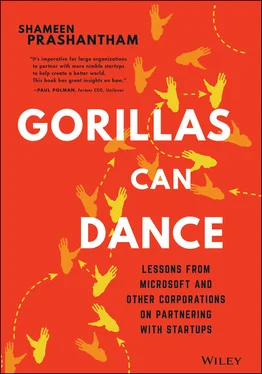The book opens with an account of Microsoft and culminates with an outline of the book's six chapters, with two each in three parts: Why, How, and Where. Each part highlights an important mindset: entrepreneurial, collaborative, and global, respectively. An Epilogue at the end briefly highlights the importance of all three mindsets, which represent an important takeaway that transcends this book's specific focus on corporate-startup partnering.
Thinking about these mindsets, as I have been completing this manuscript, has prompted a fair bit of reflection about the intersection of globalization and entrepreneurship, which in essence is what partnering between large multinationals and entrepreneurial startups represents.
Such reflection has been greatly influenced by the Covid-19 pandemic.
While this book has been well over a decade in the making, the home stretch of the writing effort to complete the manuscript took place against the unprecedented backdrop of the havoc wreaked, including on my travel plans to China, by the Covid-19 pandemic. As a result, I unexpectedly found myself progressing this book in my hometown of Vellore, in southern India. This meant that, after many years, I was back in the house I'd grown up in as a child.
That building was built over 250 years ago by the East India Company as an indigo factory. The East India Company was a “born global” – the epitome of globalization and entrepreneurship of its era. Many years later, the building was sold to the Reformed Church of America, where the Scudder family – a prominent medical missionary family – lived at the turn of the nineteenth century. In 1900, Ida S. Scudder, a third-generation medical missionary, started a one-bed dispensary in that building – quite literally, a startup – that eventually became the Christian Medical College (CMC) Hospital. Today, with more than 2,500 beds and a fine medical college, it is one of India's top teaching hospitals and a non-profit organization that assiduously seeks to serve the poor. Later, the building came to house the offices and director's residence for an organization founded in 1970, the Christian Counselling Centre (CCC), which has continued the tradition of non-profit service.
Arguably, this building offers diametrically opposing illustrations of how global and entrepreneurial mindsets can intersect. At one extreme, scholars such as Jeffrey Sachs suggest that, at least from the perspective of the country that is included in its name, the East India Company represented exploitative globalization. By contrast, organizations like these non-profits in Vellore that came into existence in this very building were also arguably conceived and built on the basis of global and entrepreneurial mindsets, but with an ethos of service that is very different.
Of course, for most for-profit organizations today, the optimal balance will lie somewhere in between these extremes. But in a post-Covid world, there may be merit in leaning more toward the Vellore non-profits' mindset than that of the East India Company, an erstwhile vehicle of imperialism. And it is collaboration – between dissimilar actors – that may be the lynchpin that helps to harness the benefits of entrepreneurship and globalization.
This is why I am particularly gratified to observe corporations like Microsoft, Unilever, and others explicitly incorporate a focus on the United Nations' Sustainable Development Goals (SDGs) in some of their startup partnering activities. Corporate-startup partnering thus holds promise for social impact. This prospect – and the accompanying urgency – has only increased with the debilitating social and economic effects of the Covid-19 pandemic. I truly believe that as corporations and startups partner together more effectively for mutual benefit, there can be outcomes – economic and social – that enhance well-being, productivity, and meaningfulness in life. But this is easier said than done, and it is my hope that the lessons in this book will help a little to make that a reality.
Shameen Prashantham
PROLOGUE MICROSOFT'S STARTUP PARTNERING JOURNEY
Microsoft's one of the few companies we were able to partner with that actually worked for both companies … Bill [Gates] and Microsoft were really good at it because they didn't make the whole thing in the early days and they learned how to partner with people really well.
– Steve Jobs 1
MICROSOFT: A CASE STUDY IN STARTUP PARTNERING
In October 2010, Microsoft organized an event, billed as the One Summit, at its Silicon Valley campus in Mountain View, California. While Microsoft was well known for its partner-related events and activities, this summit for startups was a first for the company. The event marked the soft launch of a program called BizSpark One, a partnering initiative through which Microsoft partnered with 100 of the most innovative startups that used its technologies, selected from over thousands that had signed up to its BizSpark program launched in 2008. The majority of the startups in that room were from North America and Western Europe.
Fast-forward to April 2019. Walmart CEO Doug McMillon was in Shanghai, China, and one of the local initiatives that he spent time learning about was Omega 8, a partnering program through which that retail giant could work with local startups to solve their pain points. A few startups that had gotten to work with Walmart in China through this program demonstrated their solutions. Apart from the apparent prowess of those startups, the win-win outcomes for them and Walmart, and the high-level executive attention the program had attracted, there was something else that was striking: most of those Chinese startups were alumni of the Microsoft Accelerator program.
I was fortunate to be present at both those meetings as an academic researcher. For well over a decade, as part of my ongoing research program I have studied how Microsoft (and many other corporations discussed in this book) partnered with startups. For me, Microsoft's journey of partnering with startups across time and locations is an excellent case study for three reasons.
First, Microsoft took startup partnering seriously, yet had to work hard to figure things out – therefore there was plenty for me to study, over time and across space. Partnering has been in Microsoft's DNA, as acknowledged by Steve Jobs. Yet, even Microsoft has had to work hard at startup partnering. A key point of the story is that Microsoft's current status as a partner of choice for many digital startups didn't happen overnight; it has been effort ful , not effort less .
Second, I was fortunate to gain access to relevant Microsoft managers across several regions, over a considerable period of time – therefore I could observe an unfolding journey. My exposure to Microsoft began in June 2003 during a fortuitous visit to its headquarters in Redmond, Washington. Since then, many Microsoft managers, startup partners, and other ecosystem members have been generous with their time and stories with me over the years, as I embarked on a study of corporate-startup partnering. Spanning over a decade and a half, my research on Microsoft covers multiple geographies including China, India, Israel, Kenya, South Africa, the UK, and the United States, among others. On occasion, I have even found myself telling Microsoft managers stories about the past that they weren't aware of!
Third, it is a story about a learning journey – and thus offers lessons for all companies that are committed to partnering with startups, even traditional ones. Today, startup partnering is relevant to corporations in all industries. As seen, traditional companies like Walmart could partner with startups alongside a technology company like Microsoft. Moreover, in this era of digitalization, all companies are becoming software companies, as Microsoft CEO Satya Nadella often says. Everyone can learn from the Microsoft story.
Читать дальше












